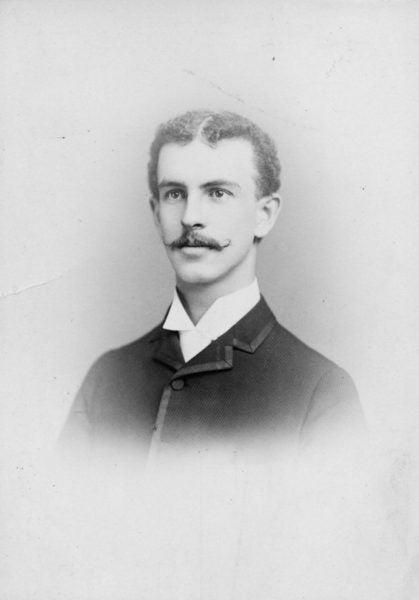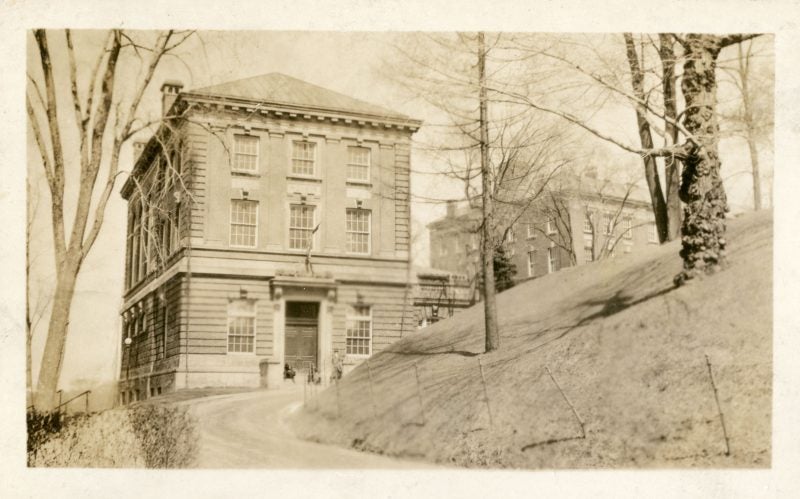William Weightman Walker
William Weightman Walker[edit]
William Weightman Walker was born in Philadelphia, PA on January 6, 1865 [1]. He moved to Troy, NY to attend Rensselaer Polytechnic Institute, graduating in the class of 1886 with a degree in Chemistry. While at RPI, he was a member of the Delta Phi Fraternity in addition to being an active member in the Troy Citizen’s Corps and Read steamer company [2]. After RPI, he went to Philadelphia to study medicine at the Jefferson Medical College, the to set up a practice, moved to Denver, CO. Walker was described as an “able student,” with great success in his future if not for his untimely death. Dr. William Weightman Walker died at the age of 27 in April of 1891 [3] from typhoid [4].

William Weightman Walker
Walker Laboratory[edit]
Walker Laboratory was one of the first two buildings constructed on the newly acquired Warren estate property, which was purchased in 1905 for $125,000. Moving up the hill to the Warren property was the direct result of several fires that damaged the existing campus. The fires being the Great Fire of 1862 burning down the entirety of RPI at the time, and a fire in May 1904 burning from the Winslow Laboratory. With another fire in June 1904 burning the Main Building [5]. With the addition of Carnegie and Walker, the campus now had nine total buildings on the campus [6]. The building was financed by Mrs. Anne Weightman Walker, and named for her son Dr. William Weightman Walker. Anne Weightman Walker was considered to be one of the wealthiest women in the world. She inherited her husband’s $10 million estate and then a year later her father’s $60 million estate (in 1904). Her father was a chemist who had a monopoly on quinine during the Civil War and was considered the wealthiest man in Philadelphia. He was said to have given a $4 million gift to William in the hopes of him traveling the world [4]. The gift to construct the laboratory totaled $200,000 (in 1905) and allowed for the building of the state of the art facility. The facility allowed “thirty-six men can use H2S at once, while sixty-four are enabled to boil solutions or evaporate them to dryness at one time.” Walker Laboratory was designed by Lawler & Haase and named for Dr. William Weightman Walker at the time of its opening in 1906 [6].

Walker Laboratory
Legacy[edit]
An addition to Walker Laboratory was added in 1919, with a formal two-year renovation occurring in 1996. This renovation allowed for more modern chemistry equipment and allowed for new wet labs and classroom orientations [1]. Walker Laboratory continues to be the main laboratory space for students in chemistry, biology and biological engineering. In addition, the William Weightman Walker namesake has continued on as being the one of two oldest endowed professorships at RPI, and one of the highest honors bestowed on a faculty member [7].
Citations[edit]
[1] Mason-Henry Press. (1908). Delta Phi Catalogue of the members of the fraternity 1827-1907.
[2] Home. Walker Laboratory. (n.d.). Retrieved February 23, 2023, from https://archives.rpi.edu/institute-history/building-histories/walker-laboratory#:~:text=Walker%20Laboratory%20has%20housed%20the,the%20most%20advanced%20studio%20classrooms
[3] In Memory of a Graduate. (1907, June 12). The Troy Times.
[4] Anne Weightman: One of the wealthiest women in the world. (2014, July 13). Williamsport Sun-Gazette.
[5] Home. Continuing up the Hill: The Warren Property. (n.d.). Retrieved February 23, 2023, from https://archives.rpi.edu/blog/2014/06/06/continuing-up-the-hill-the-warren-property/
[6] Home. Walker Laboratory. (n.d.). Retrieved February 23, 2023, from https://archives.rpi.edu/institute-history/building-histories/walker-laboratory#:~:text=Walker%20Laboratory%20has%20housed%20the,the%20most%20advanced%20studio%20classrooms
[7] Rensselaer Polytechnic Institute (RPI). Separations Expert Named William Weightman Walker Professor at Rensselaer | News & Events. Retrieved February 23, 2023, from https://news.rpi.edu/luwakkey/2345